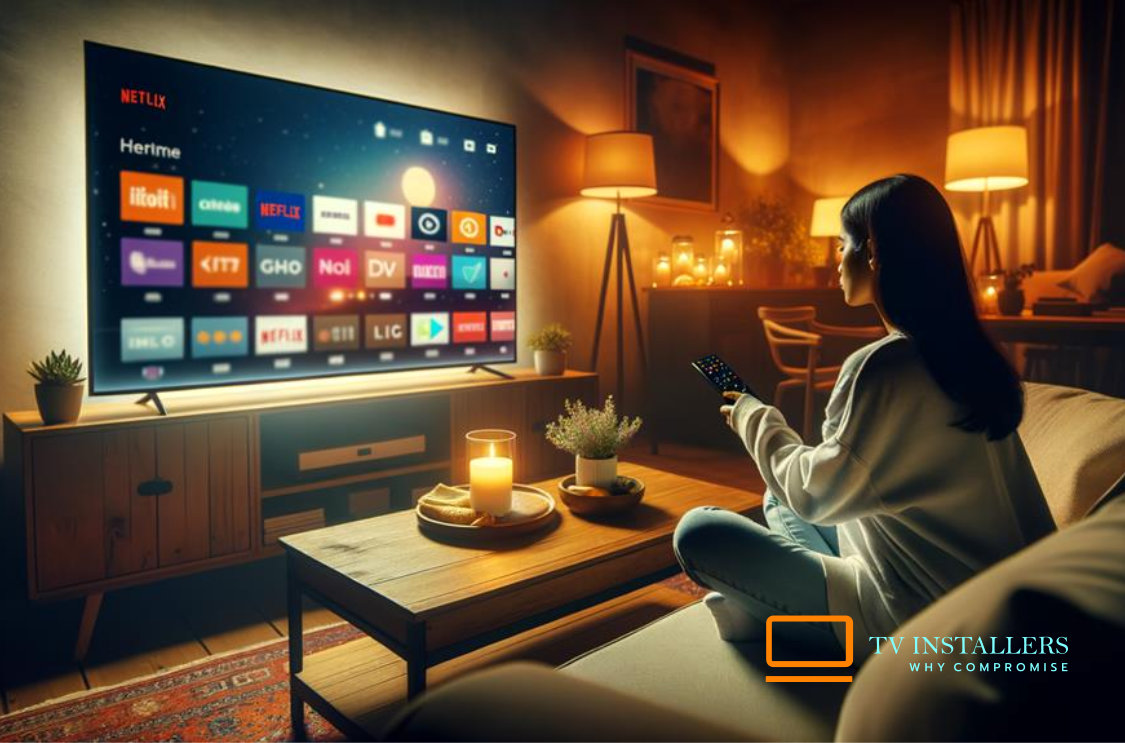To watch TV without an aerial socket, use internet-connected devices such as smart TVs, streaming sticks, or set-top boxes.
Smart TVs connect to Wi-Fi and let you stream channels and on-demand services through built-in apps.
Streaming sticks like Roku plug into your TV’s HDMI port and access content via Wi-Fi.
Set-top boxes, such as Amazon Fire TV, offer live TV and on-demand shows without the need for an aerial.
Online streaming services like Netflix, Amazon Prime Video, and Hulu provide extensive content libraries, requiring only a subscription and a stable internet connection.
Discover these versatile solutions and enhance your viewing experience seamlessly.
Key Information
- Use a smart TV with built-in apps to stream live TV and on-demand content via Wi-Fi.
- Connect a streaming stick like Roku to the TV’s HDMI port for access to various channels and apps.
- Utilise set-top boxes such as Roku or Amazon Fire TV for seamless streaming of live TV and on-demand content.
- Subscribe to online streaming services like Netflix or Hulu to watch TV shows and movies on compatible devices.
- If you require TV wall mounting, simply click the “Book Now” button and follow the steps to secure your appointment.
Internet-Connected Devices
With internet-connected devices like smart TVs, you can stream a vast array of live TV, on-demand shows, and movies directly through your TV without needing an aerial socket.
By connecting your TV to Wi-Fi, you gain access to numerous channels and streaming services.
These devices use apps and online platforms to deliver content, eliminating the need for a traditional aerial connection.
The setup is straightforward: just connect your device to the internet, download the necessary apps, and start streaming.
This method offers flexibility and convenience, allowing you to watch a wide range of entertainment options anytime.
Plus, it’s perfect for those who prefer not to deal with the hassle of physical aerial connections.
Smart TVs
Smart TVs revolutionise home entertainment by connecting to Wi-Fi and offering seamless access to a variety of channels and streaming services through built-in apps.
You won’t need a traditional aerial socket anymore.
Simply verify that your smart TV has USB and HDMI ports for compatibility with external devices.
Some channels, like BBC, might still require a TV license, so check regulations to stay compliant.
These TVs provide a cable-free solution for accessing live TV channels, needing only a reliable Wi-Fi connection.
With internet connectivity, you can browse and stream effortlessly, making your TV viewing experience more versatile and convenient.
Smart TVs replace the need for cumbersome setups by integrating everything into one sleek, connected device.
Streaming Sticks
If your Smart TV doesn’t fully meet your needs, streaming sticks offer an additional, plug-and-play solution for accessing a wide range of channels and apps directly through your TV’s HDMI port.
Devices like Roku can provide access to live TV, catch-up services, and on-demand content, greatly expanding your viewing options.
Simply plug the streaming stick into the HDMI port and power it using your TV’s USB port. This eliminates the need for extra power sources.
With a dedicated remote control, you can easily navigate and select channels.
Streaming sticks are an efficient way to bypass the need for an aerial socket, offering a diverse TV experience with minimal setup.
Set-Top Boxes
Set-top boxes like Roku and Amazon Fire TV offer an excellent solution for those wanting to watch live TV and on-demand content through their TVs without relying on an aerial socket.
These devices connect to your TV via an HDMI port and link to your Wi-Fi network, enabling seamless streaming of various channels and content.
You’ll find a wide array of channels and services, although some may require a subscription for premium content.
Set-top boxes are especially popular because they provide a clean, clutter-free setup and an intuitive interface.
Simply plug in the box, connect to your Wi-Fi, and start exploring a world of entertainment options without the need for traditional TV antennas.
Online Streaming Services
Beyond the convenience offered by set-top boxes, online streaming services like Netflix, Amazon Prime Video, and Hulu provide a robust alternative for accessing a vast library of TV shows and movies directly through the internet.
You can stream your favorite programs on smart TVs, laptops, tablets, and smartphones, eliminating the need for an aerial socket.
These platforms typically require a subscription fee, granting you access to an extensive content library.
With on-demand streaming, you can watch entertainment on your own schedule, making it a flexible option compared to traditional TV viewing.
To get started, you’ll need a stable internet connection and a compatible device, ensuring you’re all set to enjoy seamless streaming anytime, anywhere.
Portable Aerials
Portable aerials provide a versatile solution for receiving TV signals without relying on an aerial socket, allowing you to set up a dedicated signal receiver in any room.
These standalone devices capture signals from nearby transmitters, eliminating the need for extensive cabling.
Keep in mind, signal reception can vary based on the aerial’s location and potential obstacles like buildings or trees.
For best results, test smaller portable aerials in various spots around your home to find the most suitable signal strength.
This method offers convenience and flexibility, making it easier to access TV broadcasts without a traditional aerial socket.
Remember, the key is to experiment with placement to overcome any reception challenges.
Frequently Asked Questions
Can I Use a TV Without an Aerial Socket?
Yes, you can. Use indoor aerials, portable antennas, or smart TVs with internet connectivity. Devices like Roku sticks offer channel access. Make sure your TV has USB and HDMI ports for device compatibility and seamless viewing.
How Do I Watch Free-To-Air TV Without an Aerial?
You can watch free-to-air TV without an aerial by using a Roku stick, indoor aerial, smart TV apps, screen mirroring from a smartphone, or an AV sender. Each method offers a wireless solution for TV viewing.
How Do I Get Freeview on My TV Without an Aerial?
You can access Freeview on your TV without an aerial by using a smart TV with an internet connection, a streaming device like Roku, or Freeview Play. Alternatively, opt for indoor aerials or communal aerial systems.
What Can I Use if I Don’t Have a TV Aerial?
If you don’t have a TV aerial, you can use a Roku stick, an indoor aerial, or a smart TV connected to Wi-Fi. Screen mirroring and AV senders are also effective alternatives for accessing TV channels.
Conclusion
To sum up, you don’t need an aerial socket to enjoy TV. With an internet connection, smart TVs, streaming sticks, set-top boxes, and online streaming services provide numerous alternatives.
Additionally, portable aerials can offer flexibility for traditional broadcasts.
By leveraging these modern technologies, you can access a wide range of content without the need for conventional aerial infrastructure.
So, explore these options and transform your TV viewing experience effortlessly.
If you require TV wall mounting, simply click the “Book Now” button and follow the steps to secure your appointment.



